
We would like to thank ZOTAC for providing us with a review sample of their ZOTAC GAMING GeForce RTX 2070 Mini. Without their generosity, this graphics card review would not be possible.
Fresh off the heels of our NVIDIA 2080 Ti review, ZOTAC has provided us with their ZOTAC GAMING GeForce RTX 2070 Mini. This GPU is perfect for those who don’t need as much horsepower, are using something like an HDPlex PSU, desire a short(er) length GPU, or perhaps want to buy something with a much better price to performance ratio.
Below are a few resources that ZOTAC was kind enough to provide for use in creating this review:
ZOTAC GAMING GeForce RTX 2070 Mini Product Page
ZOTAC GAMING GeForce RTX 2070 Mini Brochure
Let’s see what we’re working with here:
Table of Contents
Specifications
| Chipset Manufacturer | NVIDIA |
| GPU series | NVIDIA GeForce GTX 20 Series |
| GPU | GeForce GTX 2070 |
| Architecture | Turing TU106 (TU106-400A-A1) |
| Brand | ZOTAC |
| Model | ZT-T20700E-10P |
| CUDA cores | 2304 |
| Video Memory | 8GB GDDR6 |
| Memory Bus | 448.0 GB/s, 256-bit |
| Engine Clock | Base: 1410 MHz Boost: 1620 MHz |
| Memory Clock | 14 GHz / 14,000MHz / 14Gbps |
| PCI Express | 3.0 |
| Display Outputs | 1x DVI-D 3 x DisplayPort 1.4 (3840×2160@60Hz) 1 x HDMI 2.0b (3840×2160@60Hz) |
| HDCP Support | Yes (HDCP 2.2) |
| Multi Display Capability | Quad Display |
| 4K ready | Yes |
| VR ready | Yes |
| Recommended Power Supply | 550W |
| Power Consumption | 175W |
| Power Input | 1x 8 pin |
| API Support | DirectX 12 / 12.1 OpenGL 4.6 OpenCL 1.2 Vulkan 1.1.95 |
| Cooling | Dual Fan (90mm, 100mm) |
| SLI Support | No |
| Card Length | 8.3in /211mm |
| Card Width | Dual-Slot – 1.61in / 41mm |
| Card Height | 5.08in / 129mm |
| Weight | 1270g (2.78LBS) |
| Accessories | DP to DVI adapter User Manuals |
| Warranty | 2 years / 3 years with registration |
| Price | $530 (MSRP) |
Packaging and Contents
ZOTAC’s packaging includes their trademark black and yellow color scheme but also NVIDIA’s new RTX branding. This sample was provided to us as a loaner so not all the contents match retail. The sample we received used a universal high density foam interior and the GPU was included inside a preopened static bag. As a result, the typical internal packaging reveal is being excluded from this review.
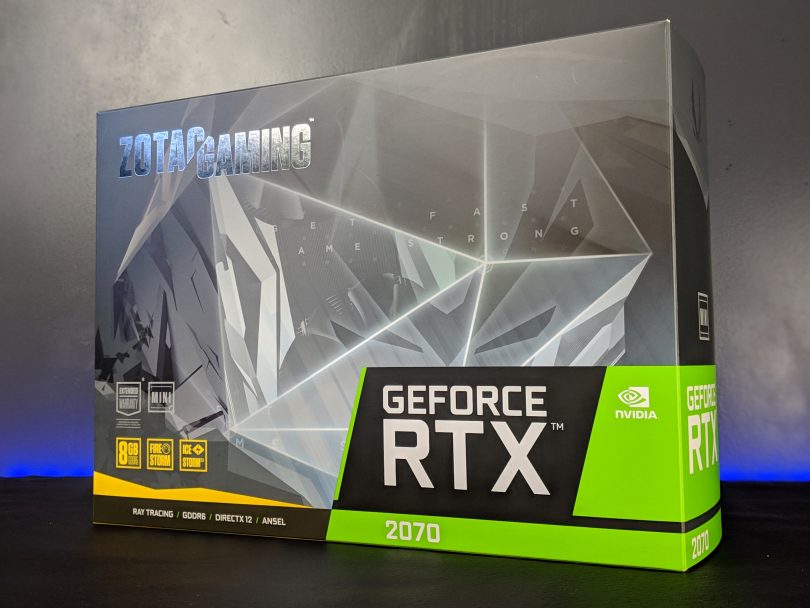
Inside is a simple envelope but the presentation is pretty appealing if I do say so myself.
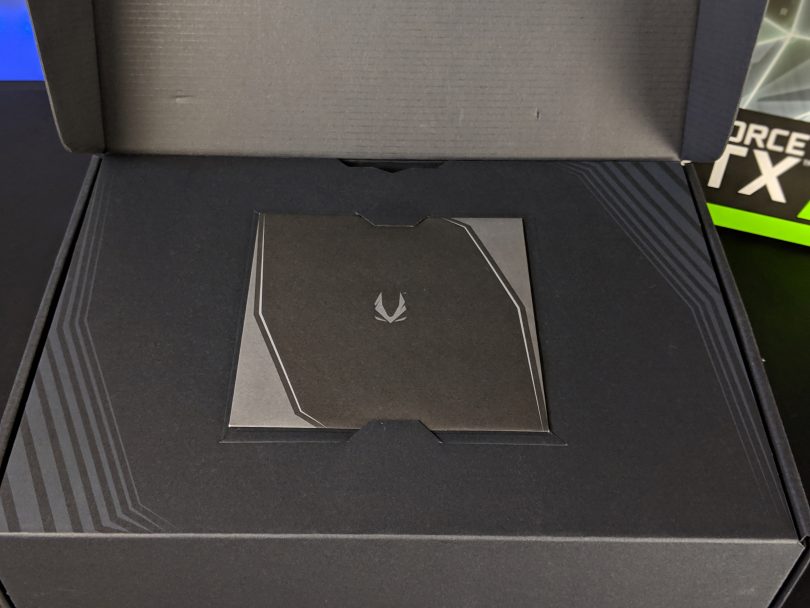
This envelope contains their Quick Installation Guide and request that you download the latest NVIDIA drivers.
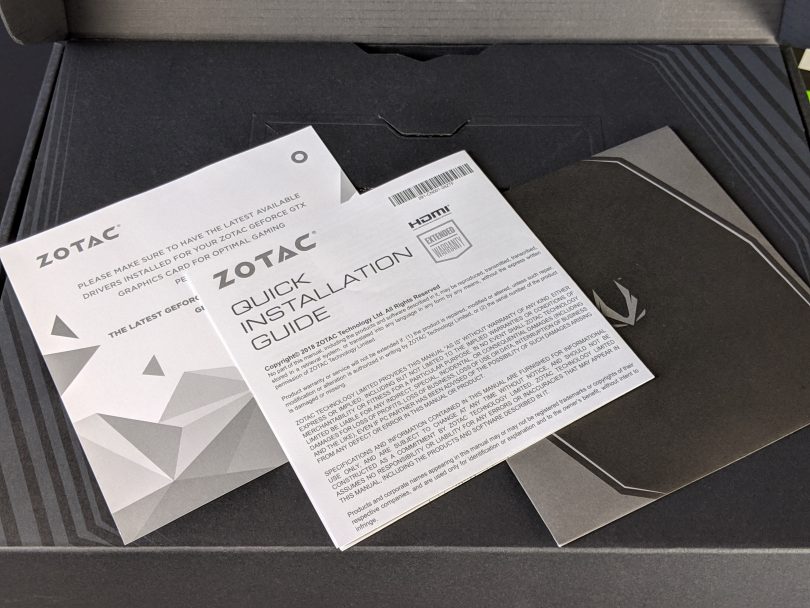
The graphics card itself features matte black plastic shroud that’s reminiscent of a stealth-bomber. It’s very similar to the shroud used on the 1080 mini that we reviewed here.
Also like ZOTAC’s 1080 mini, the left fan is a 90mm 9-blade fan that is designed for higher static pressure. The right fan is a 100mm 9-blade fan that is designed for a higher volume of airflow.
We had to promise a quick turnaround on this card so I wasn’t able to perform a proper teardown but I wouldn’t be surprised if they are the same fans from the 1080mini -and that’s not a bad thing.
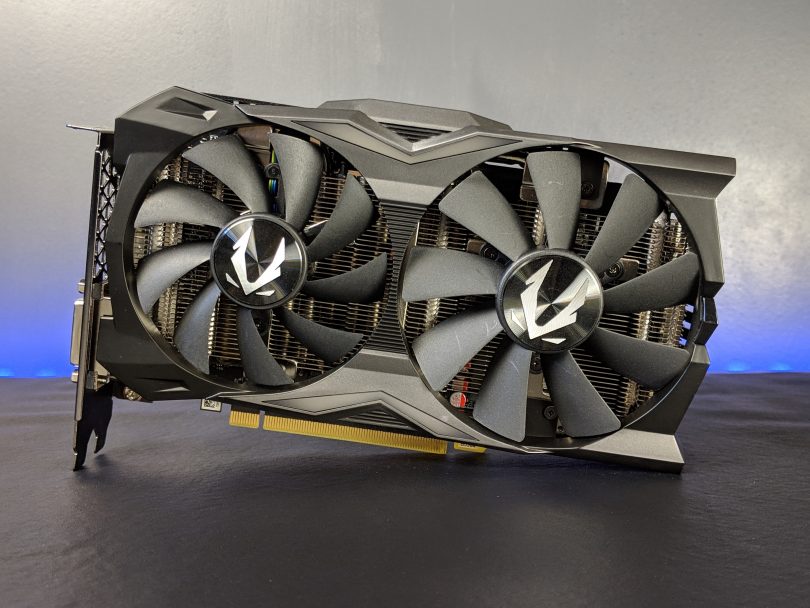
Unlike the 1080 mini that just used a simple backplate, the ZOTAC GAMING GeForce RTX 2070 Mini uses a wraparound backplate to help dissipate the heat.
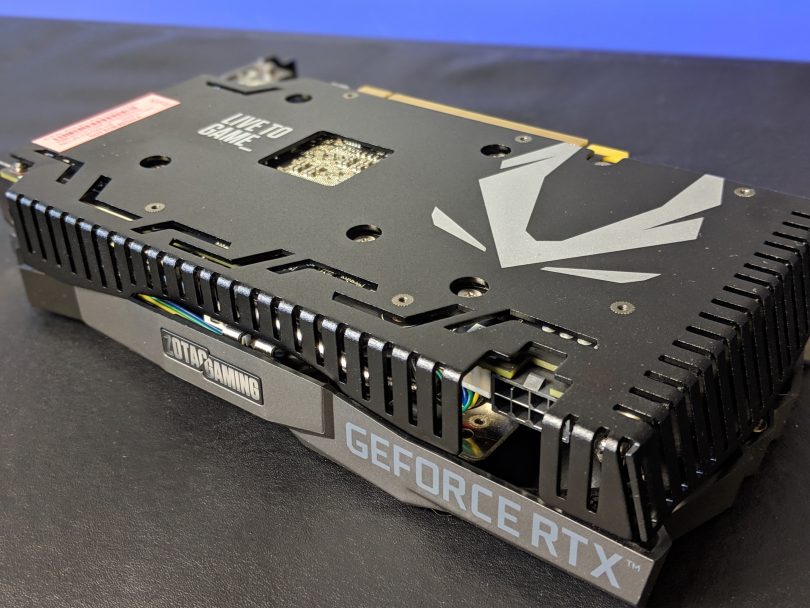
I was unbelievably happy to see that this time around, the 8-pin power connector is now recessed. We specifically requested that in our last review and we were very pleased to see it.
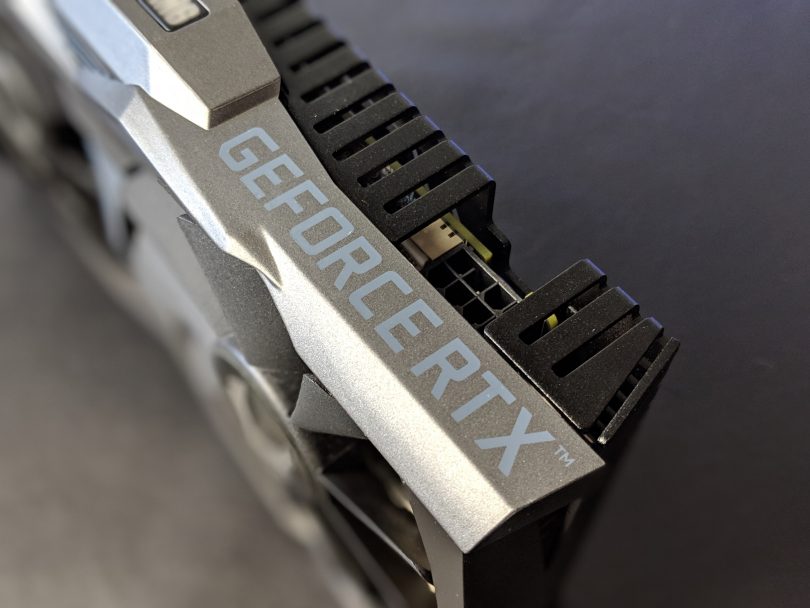
The finish on the backplate feels has a grainy feel to it and it was scratch resistant to a few gentle run-ins with a screwdriver.
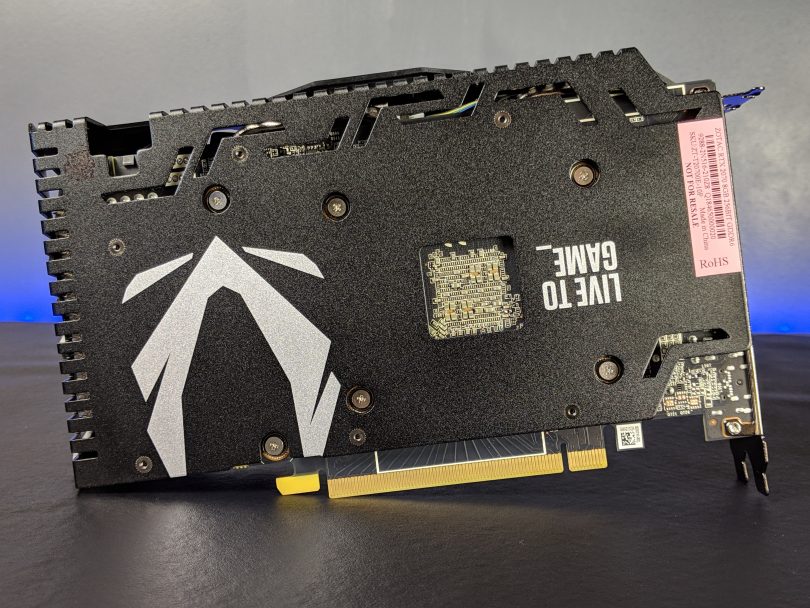
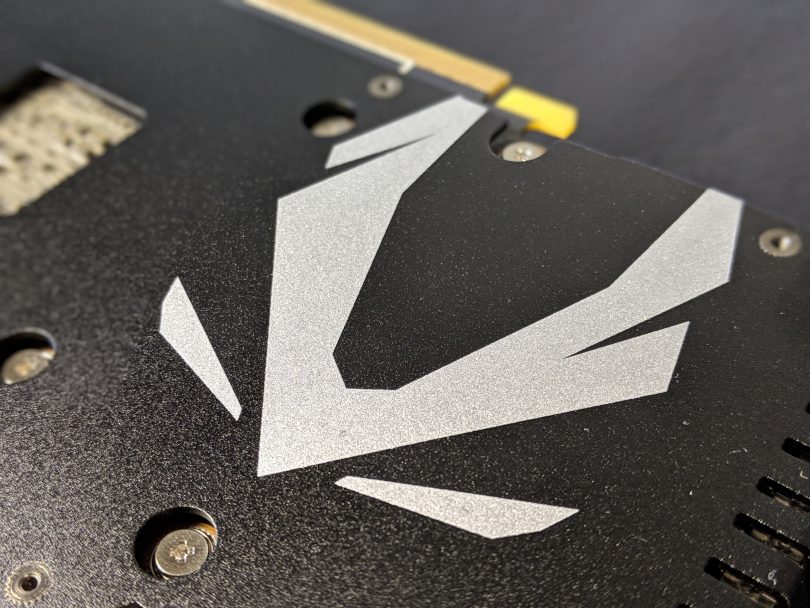
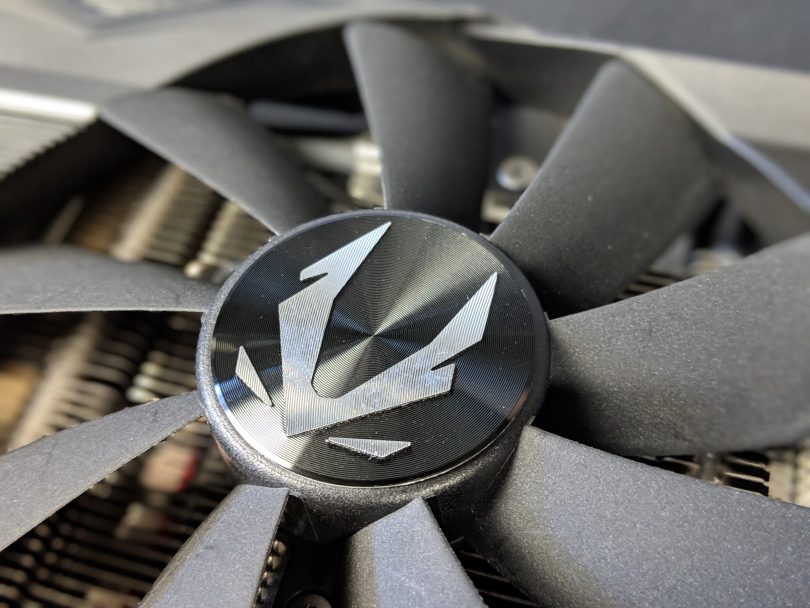
Just like the 1080 before it, this card also features 5x6mm heatpipes to evenly distribute heat generated by the GPU.
The thermal pads are installed properly and showed even coverage over the components.
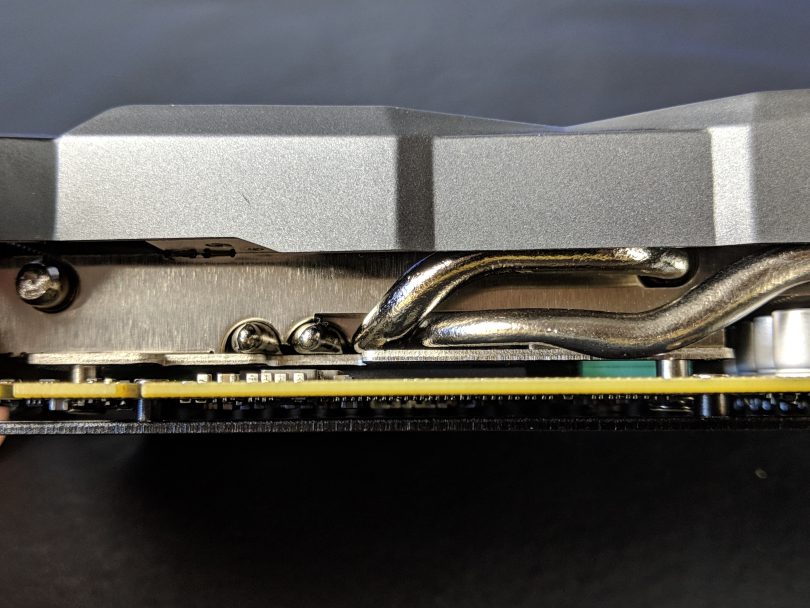
At the top of the card is the LED lit ZOTAC GAMING logo. Non-RGB. Just white.
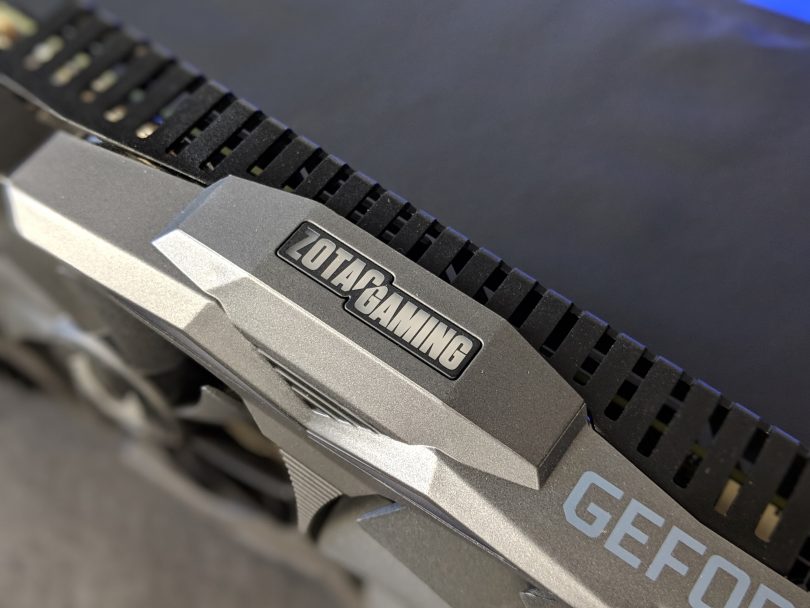
As you can see in the following two screenshots, the card offers a classy lighting aesthetic – not a rave.
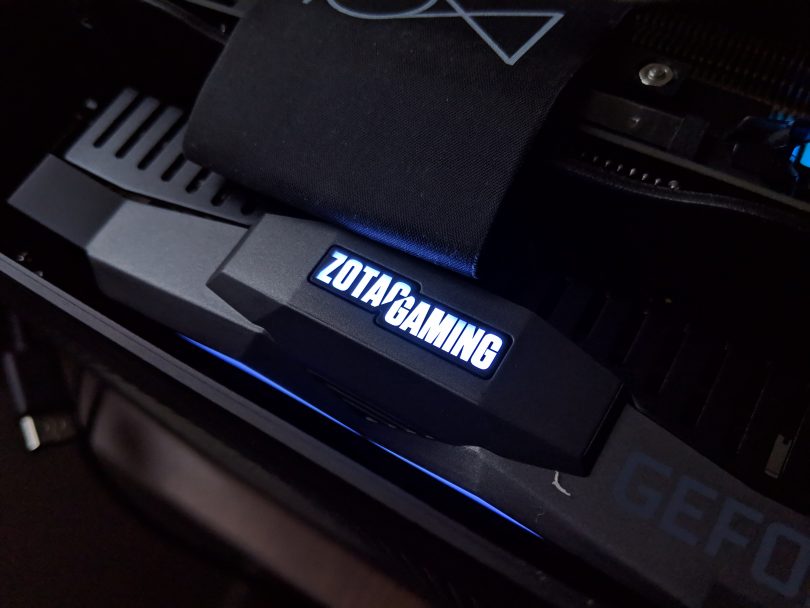
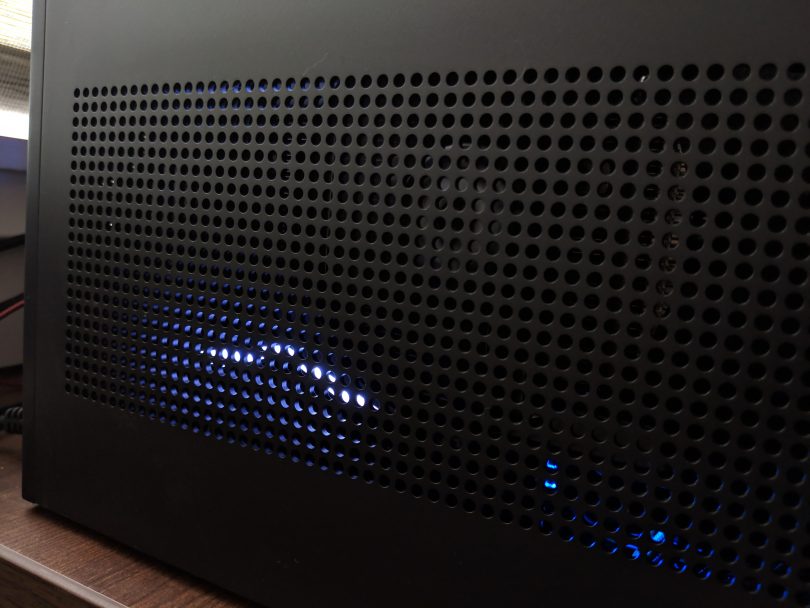
ZOTAC has opted to skip the VirtualLink for this particular variant. Instead, the ZOTAC GAMING GeForce RTX 2070 Mini features a DVI-D out. This means that next-gen VR headsets that opt to support VirtualLink will NOT be compatible with this GPU.
This may be a deal-breaker for some but from my experience (as you will soon see), this card isn’t going to be a strong contender for anyone interested in VR.
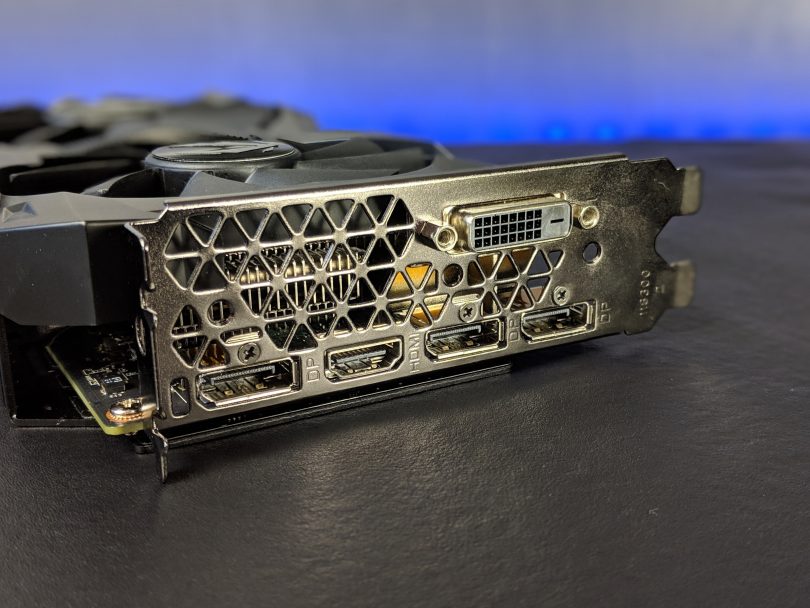
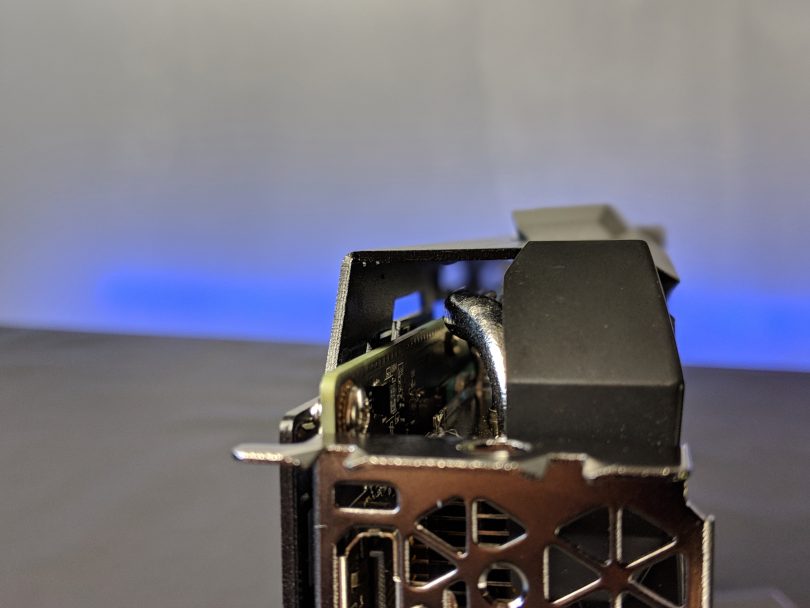
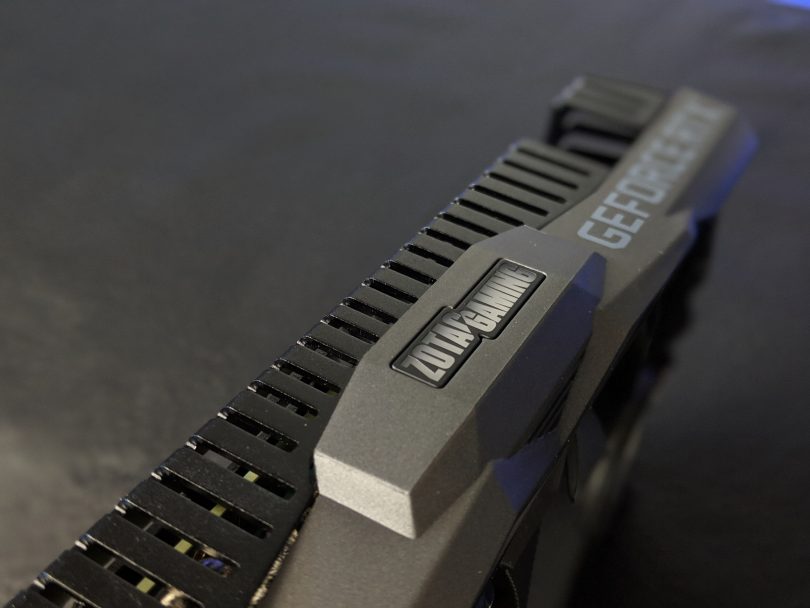
Measurements
The left fan, 90mm, measures 87mm from blade to blade.
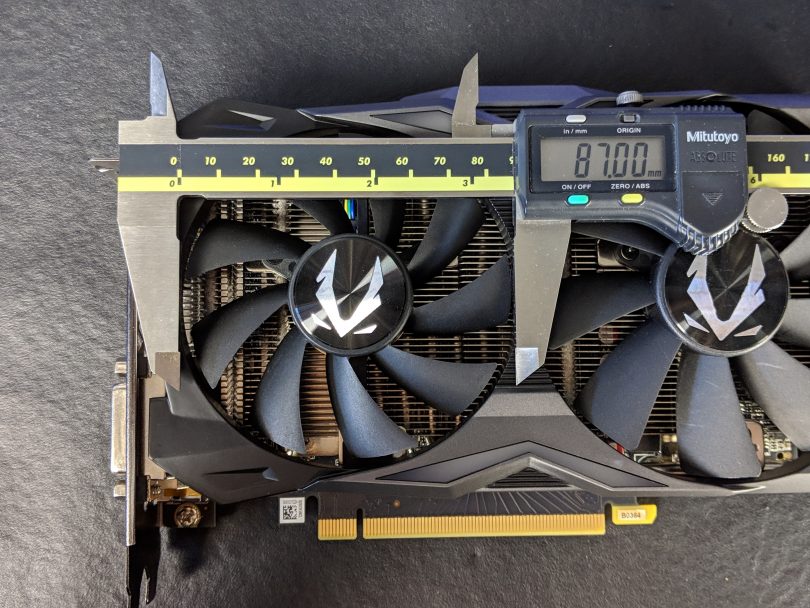
The right fan, 100mm, measures 100mm from blade to blade.
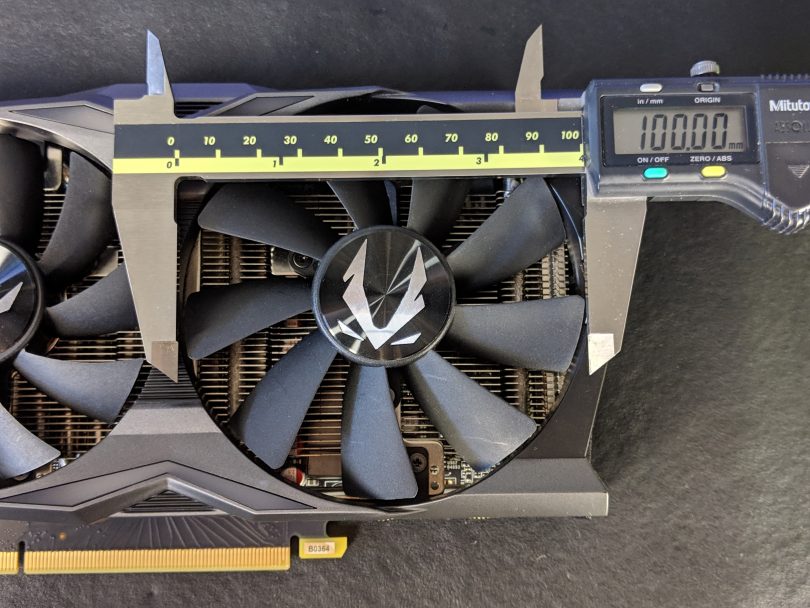
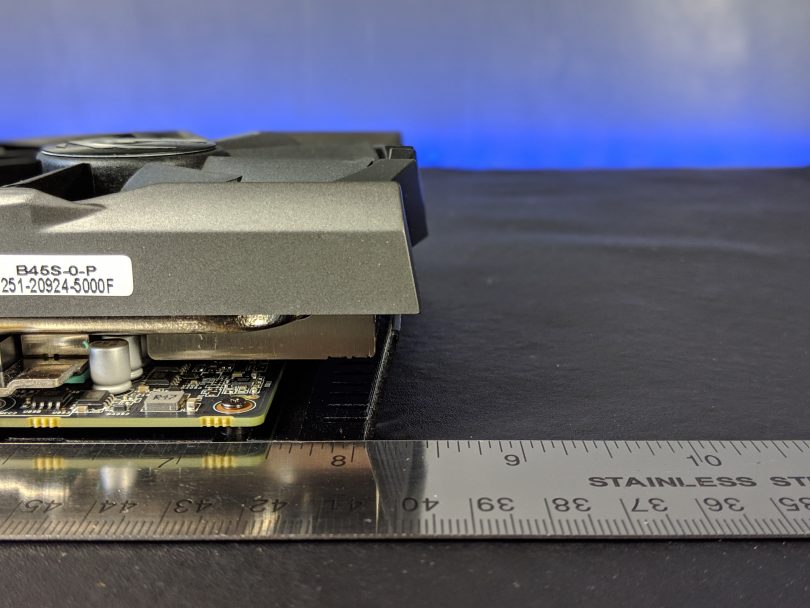
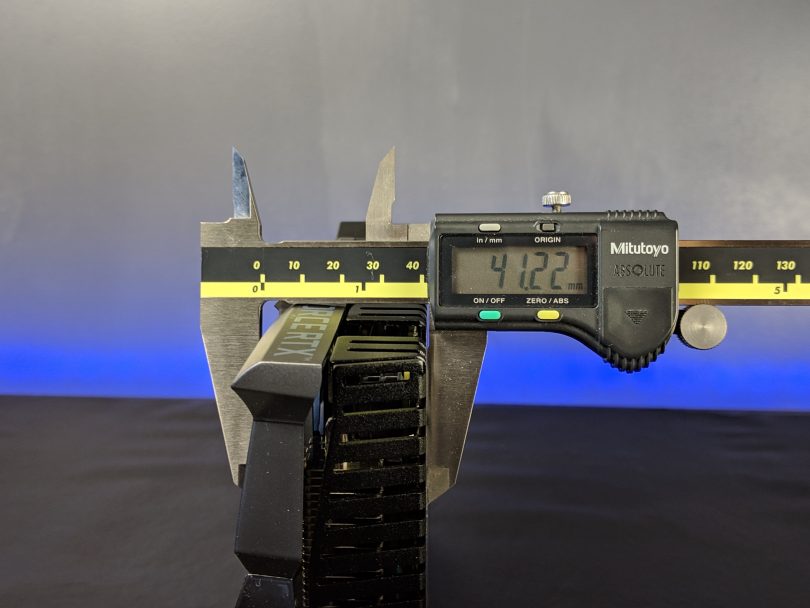
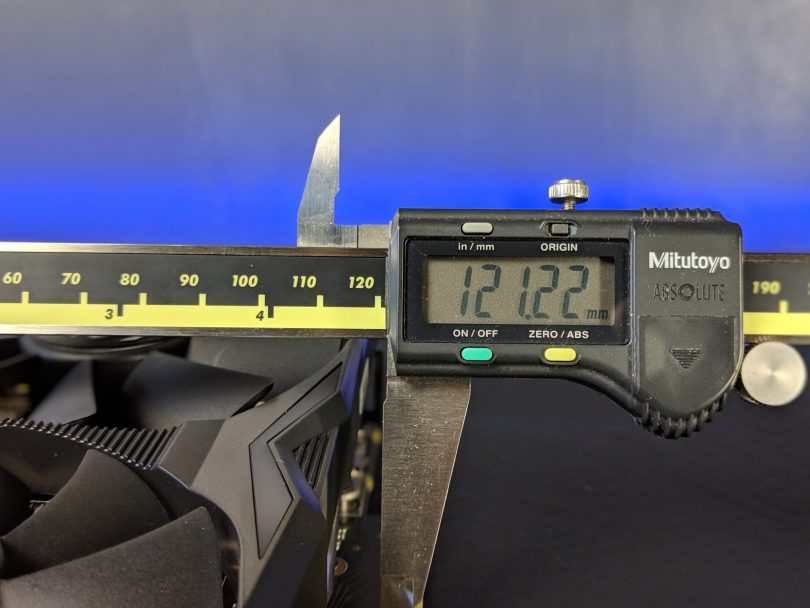
It just fits so nicely!
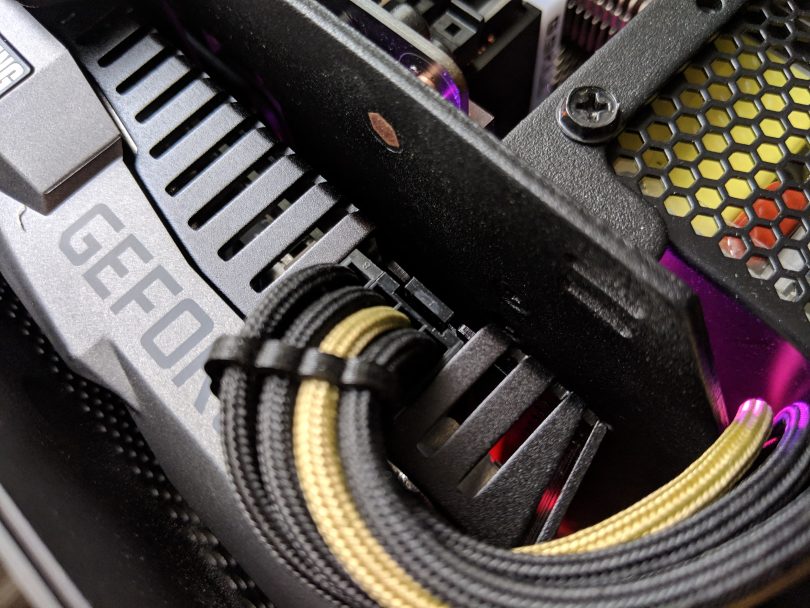
Test Setup
The test bench we have set up is a high end system.
This system was designed to help showcase the kind of computer this card’s target audience might have.
The overclock we’ve included is a mild GPU clock overclock that every single GeForce RTX 2070 should be capable of.
Overclocking the memory will yield far better results but I’m not sure if all retail cards will use the same GDDR6 memory and would get the same performance.
Also, in EVGA’s Precision X1 utility, the voltage slider doesn’t work so we’re unable to really push the limits at this time.
Slightly better scores can be obtained with a proper overclock but results will vary from one card to another.
Test bench:
CPU: AMD Ryzen 2700x (8c/16t)
Motherboard: ASUS ROG STRIX X470-I GAMING
Memory: 32GB of DDR4 @ 3200MHz (C14, 2x16GB)
Storage: 2x Samsung 960 EVO 500GB
Cooling: Noctua NH-L12
Power Supply: SilverStone SX800-LTI
Chassis: Louqe Ghost S1
Monitor: Alienware AW3418DW 34″ WQHD(3440×1440) Curved(1900R) 4ms(GTG) 120Hz(G-Sync) IPS 21:9
Software Used:
Windows 10 install (ver. 1809)
NVIDIA GeForce Driver v417.22
CPU-Z 1.86.0
GPU-Z 2.15.0
EVGA Precision X1 0.3.9.0
HWMonitor 1.37
FRAPS 3.5.99
FRAFS 0.3.0.3
System Tweaks:
GeForce Experience Disabled.
G-Sync Disabled.
Win 10 “High Performance” power mode.
Win 10 Game Bar/DVR disabled.
“Turn on Fast Startup” disabled.
Synthetic benchmarks tested:
3DMark Suite
– (DX11) Fire Strike
– (DX11) Fire Strike Ultra
– (DX12) Time Spy
– (DX12) Time Spy Extreme
(DX11) Unigine Superposition
Games tested:
(DX12) Ashes of the Singularity
(DX12) Assetto Corsa Competizione
(DX12) Battlefield V
(DX11) Dirt Rally
(DX11) Grand Theft Auto 5
(DX12) Forza Horizon 4
(DX12) Hitman (2016)
(DX12) Rise of the Tomb Raider
Graphics Cards tested:
ZOTAC GAMING GeForce RTX 2070 Mini
NVIDIA RTX2080 Ti FE
Resolutions tested:
3440 x 1440 21:9
Testing Methodology
For our tests, only the average framerates at a resolution of 3440×1440 were collected from each title.
Where possible, we used Fraps benchmarking mode to capture 60 seconds of footage and then use Frafs to collect the data.
For each game, we run with all the common settings maxed out and all the unfavorable settings disabled (ex. Gameworks options, Motion Blur, Film Grain, Bokeh, Bloom, Depth of Field, Vignette, Lens Flare, Lens distortion, Chromatic Aberration, etc etc)
Where possible, the results are also collected with anti-aliasing disabled as it’s not as big an issue at this resolution as it is at 1080p.
With each benchmark, we run three passes, average the results, and move on to the next test.
Frametimes, while incredibly valuable to the “feeling of smoothness”, were not collected for this review as our testing methodology for 2019 is undergoing an update. The data used in this review was collected mid-December.
Why 3440×1440 resolution?
– 1080p is better suited for testing CPUs.
– 1440p is the sweet spot between 1080p and 2160p. For 16:9 aspects, this is my favorite resolution for today’s graphics cards.
– 3440×1440 is the sweet spot between 1440p and 2160p. For 21:9 aspects, this is just enough to really push the limits of the GPU without bringing it to it’s knees.
– 2160p. Even the best GPUs can barely handle 4k, this card is no exception to the rule.
To reiterate, the GPU overclocks we used are mild. Every single GPU should be capable of attaining these clocks. Greater performance can be obtained by overclocking the memory but the gains may vary from one card to the next.
Game Benchmarks
Before we proceed, I just want to point out that the competition for this review is very unfair. The heavyweight champion that the ZOTAC GAMING GeForce RTX 2070 Mini is up against, the RTX 2080 TI, is NVIDIA’s flagship GPU so it should come as no surprise that the 2070 is non-competitive in this regard. However, I am using the 2080 TI to help establish a few key things worth mentioning.
Price:Performance.
We just recently learned that GDDR6 is 70% more expensive per GB than GDDR5. It’s for that very reason that the typical GB jump did NOT occur with this generation and may not occur until the price of GDDR6 drops considerably. This also means that 3rd party GPU maker’s margins have shrunk with this generation of GPUs (losing roughly $22 per card) so to see ZOTAC going the extra mile for the SFF community (as they tend to do) should not go unnoticed.
All said an done, the RTX 2070 GPUs are to be considered an outright replacement for anyone that was eager to purchase an NVIDIA GTX 1080 new. However, if you already own a GTX 1080, this card provides such subtle gains in performance that I wouldn’t recommend it.
To that end, at a cost $530, the ZOTAC GAMING GeForce RTX 2070 Mini is less than half the cost of the $1,199 2080 TI but offers a much better bang for your buck. Let’s get to it!

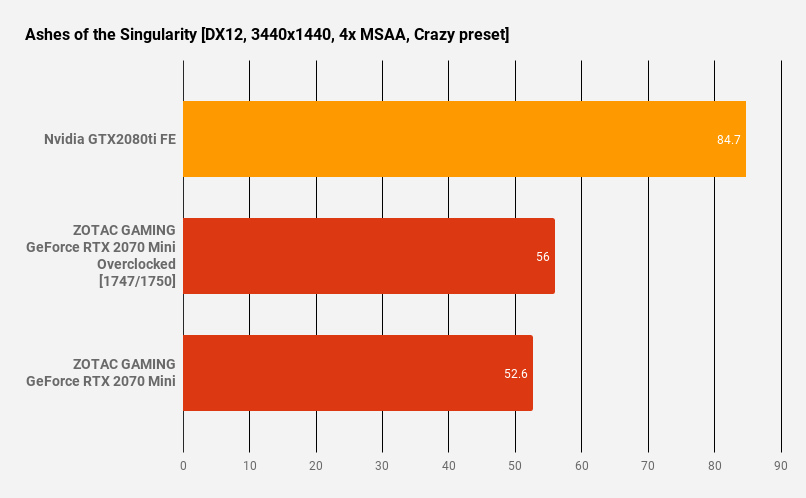
The ZOTAC GAMING GeForce RTX 2070 Mini is 37.89% slower than the RTX 2080 Ti in Ashes of the Singularity.
That gap is lessened to being 33.88% slower when overclocked.

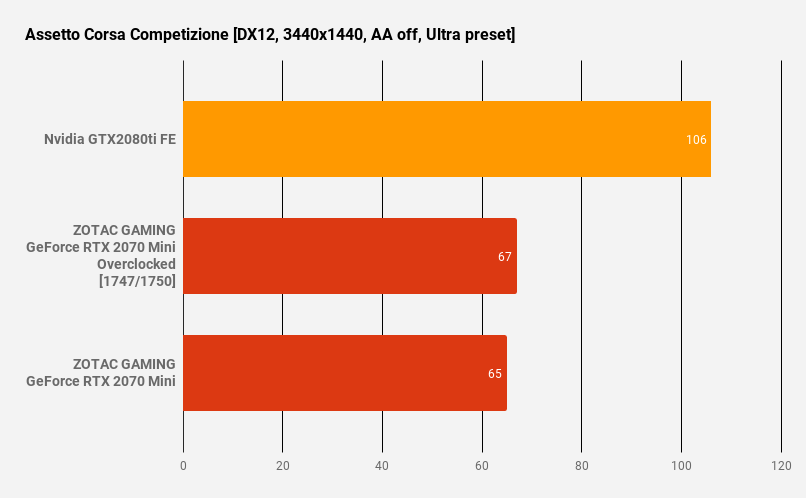
The ZOTAC GAMING GeForce RTX 2070 Mini is 38.68% slower than the RTX 2080 Ti in Assetto Corsa Competizione.
That gap is lessened to being 36.79% slower when overclocked.

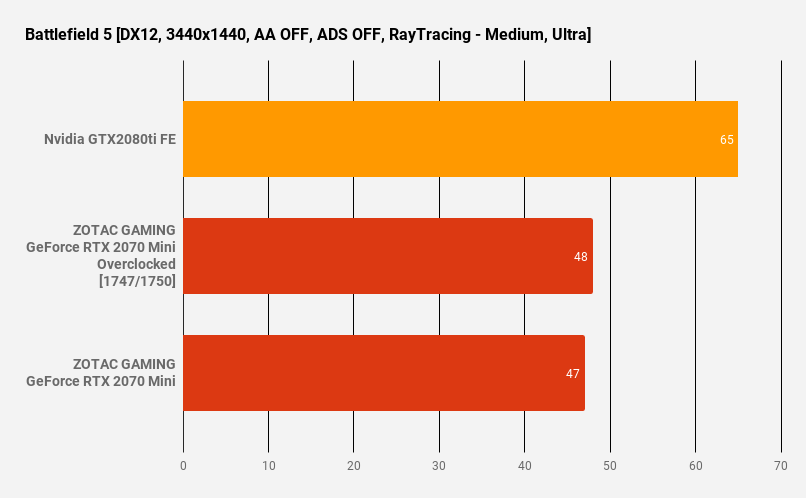
The ZOTAC GAMING GeForce RTX 2070 Mini is 27.69% slower than the RTX 2080 Ti in Battlefield 5 with Ray Tracing enabled.
That gap is lessened to being 26.15% slower when overclocked.

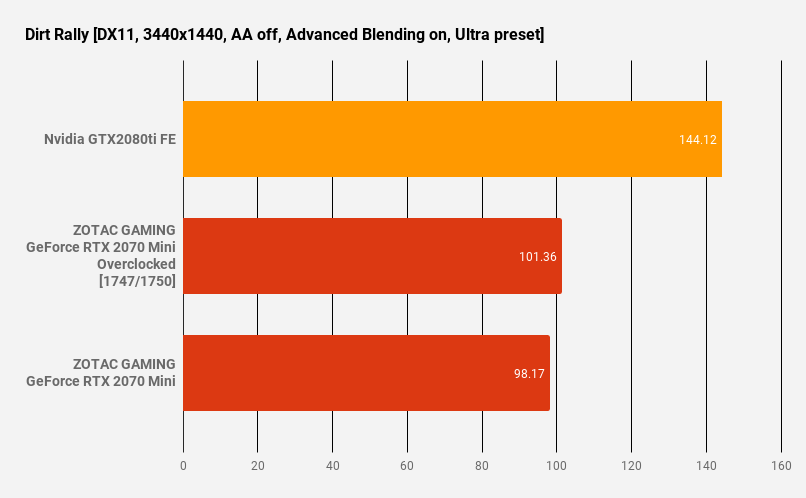
The ZOTAC GAMING GeForce RTX 2070 Mini is 31.88% slower than the RTX 2080 Ti in Dirt Rally.
That gap is lessened to being 29.67% slower when overclocked.

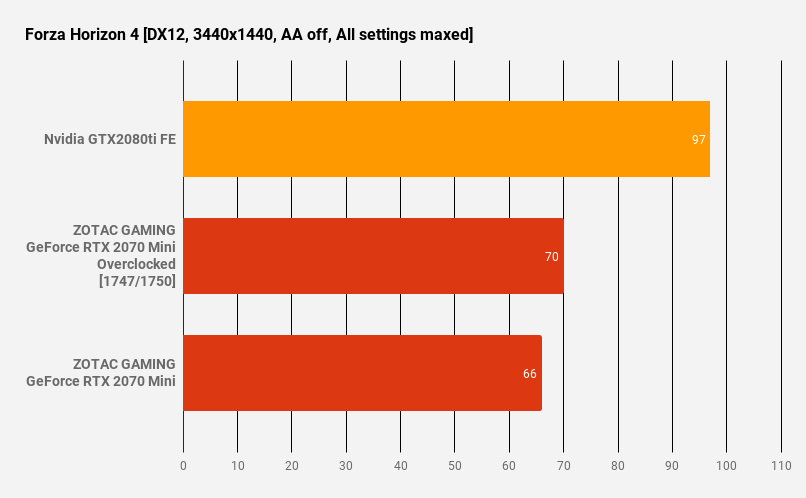
The ZOTAC GAMING GeForce RTX 2070 Mini is 31.96% slower than the RTX 2080 Ti in Forza Horizon 4.
That gap is lessened to being 27.83% slower when overclocked.

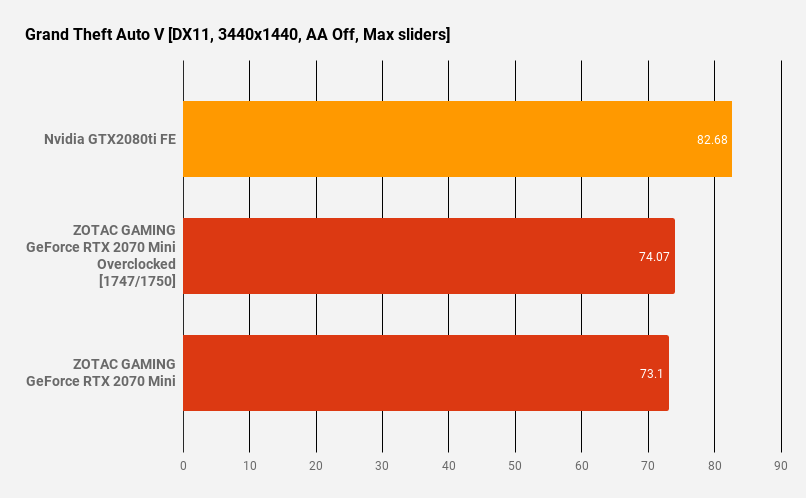
The ZOTAC GAMING GeForce RTX 2070 Mini is 11.59% slower than the RTX 2080 Ti in Grand Theft Auto 5.
That gap is lessened to being 10.41% slower when overclocked.

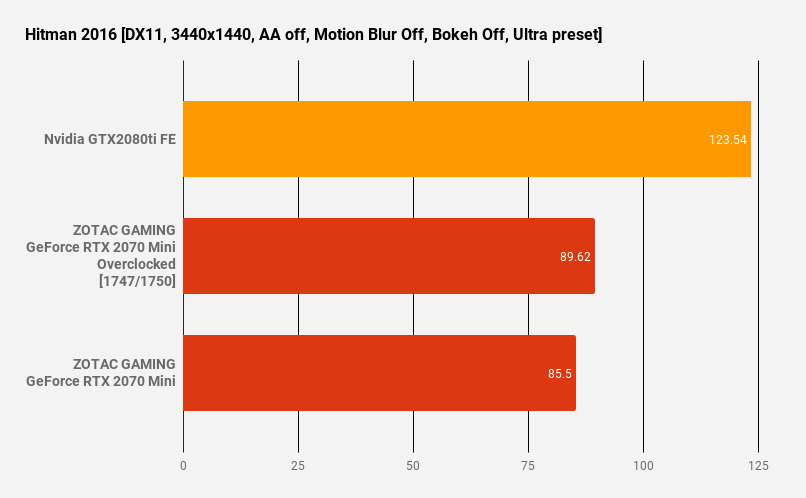
The ZOTAC GAMING GeForce RTX 2070 Mini is 30.79% slower than the RTX 2080 Ti in Hitman (2016).
That gap is lessened to being 27.46% slower when overclocked.

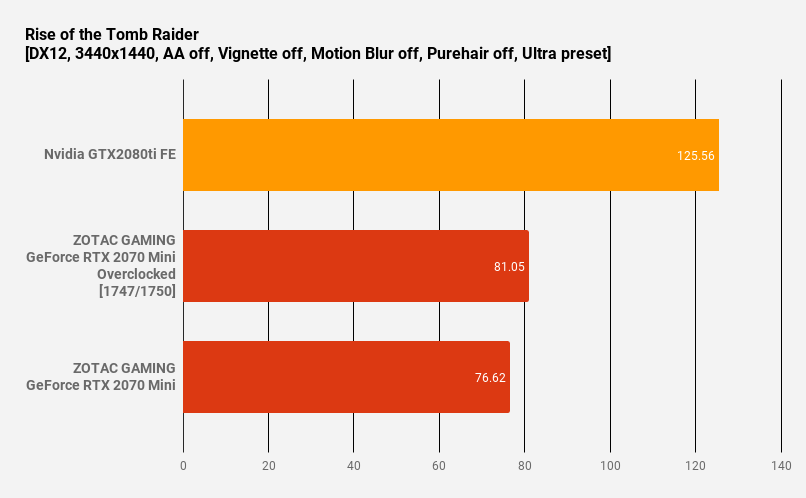
The ZOTAC GAMING GeForce RTX 2070 Mini is 38.98% slower than the RTX 2080 Ti in Rise of the Tomb Raider.
That gap is lessened to being 35.45% slower when overclocked.
Synthetic Benchmarks

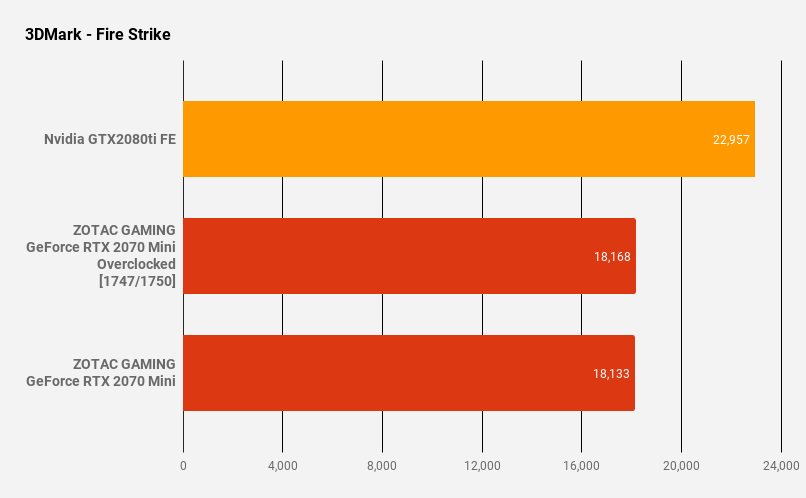
The ZOTAC GAMING GeForce RTX 2070 Mini is 21.01% slower than the RTX 2080 Ti in Fire Strike.
That gap is lessened to being 20.86% slower when overclocked.
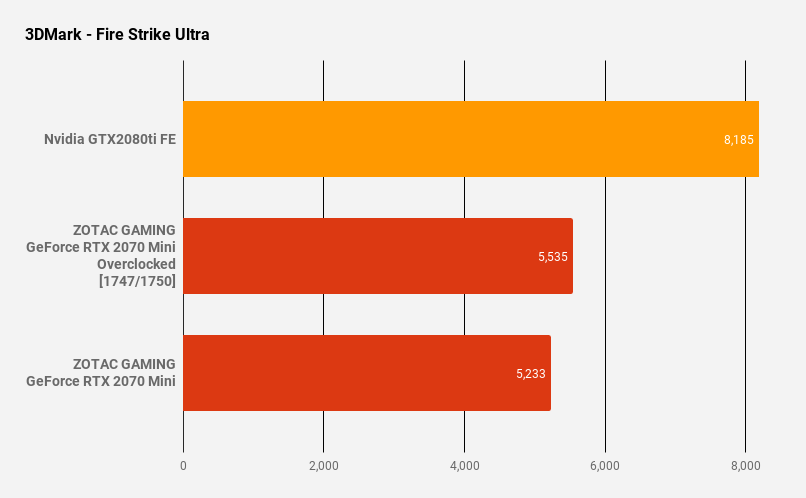
The ZOTAC GAMING GeForce RTX 2070 Mini is 36.06% slower than the RTX 2080 Ti in Fire Strike Ultra.
That gap is lessened to being 32.38% slower when overclocked.

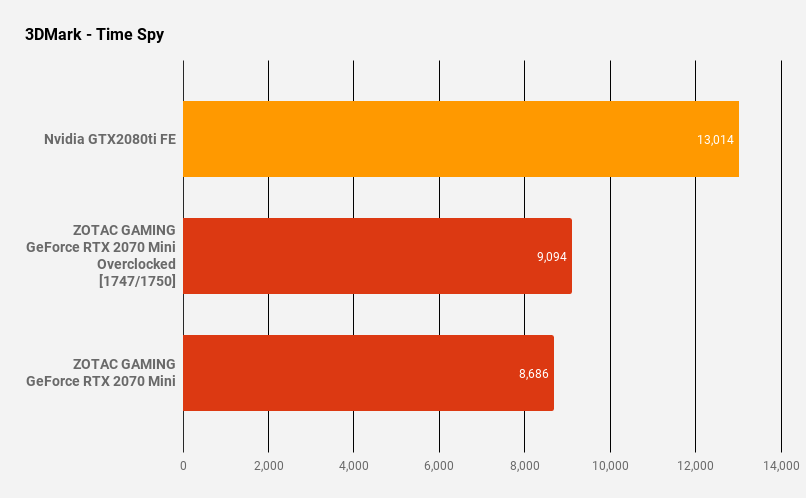
The ZOTAC GAMING GeForce RTX 2070 Mini is 33.26% slower than the RTX 2080 Ti in Time Spy.
That gap is lessened to being 30.12% slower when overclocked.
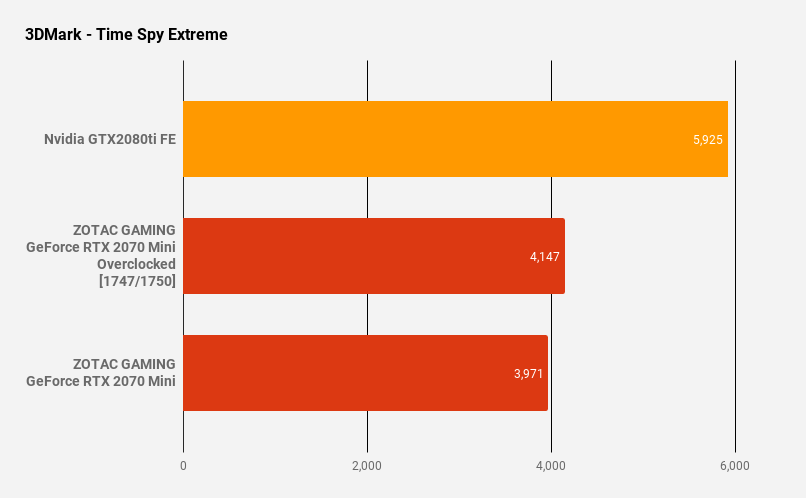
The ZOTAC GAMING GeForce RTX 2070 Mini is 32.97% slower than the RTX 2080 Ti in Time Spy Extreme.
That gap is lessened to being 30.01% slower when overclocked.

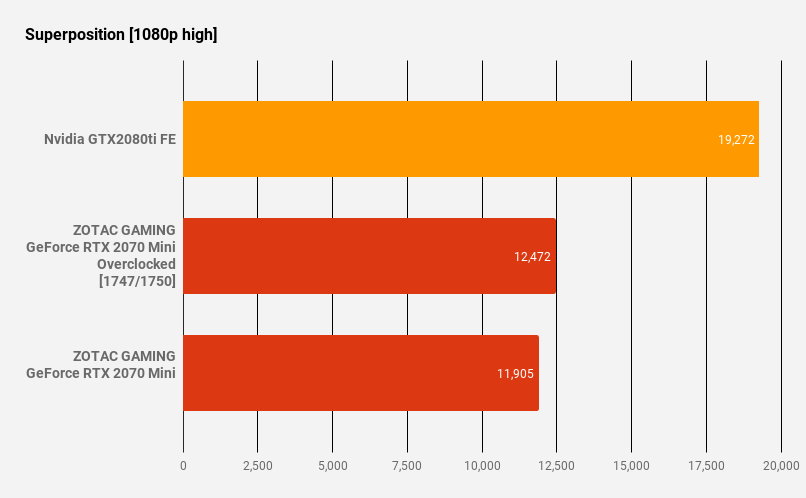
The ZOTAC GAMING GeForce RTX 2070 Mini is 38.23% slower than the RTX 2080 Ti in Superposition.
That gap is lessened to being 35.28% slower when overclocked.
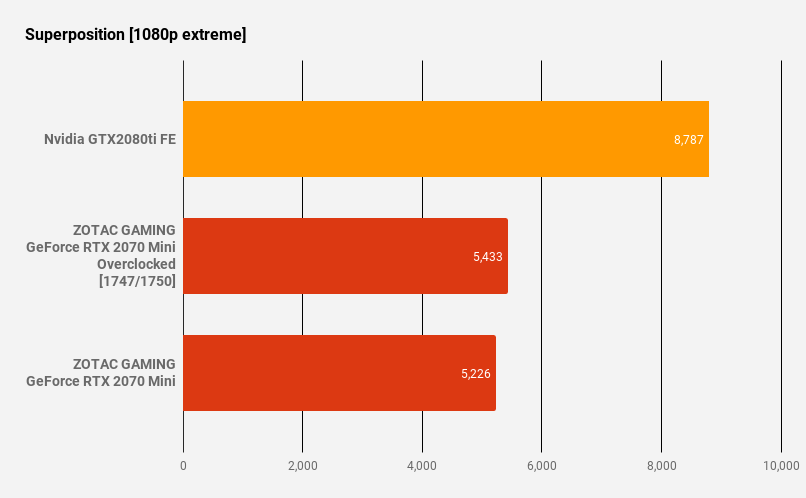
The ZOTAC GAMING GeForce RTX 2070 Mini is 40.53% slower than the RTX 2080 Ti in Superposition Extreme.
That gap is lessened to being 38.17% slower when overclocked.
Benchmark Summary
In game benchmarks, the ZOTAC GAMING GeForce RTX 2070 Mini on average was 31.18% slower than the RTX 2080 Ti.
That gap was lessened to 28.46% slower when overclocked.
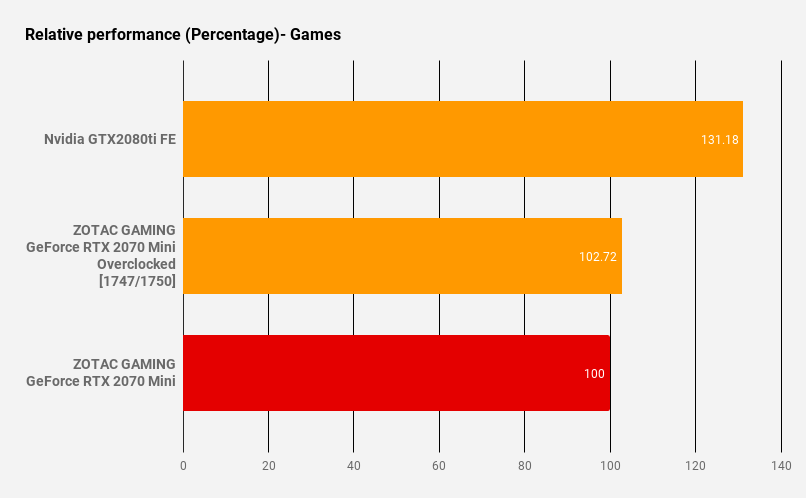
In synthetic benchmarks, the ZOTAC GAMING GeForce RTX 2070 Mini on average was 33.68% slower than the RTX 2080 Ti.
That gap was lessened to 31.14% slower when overclocked.
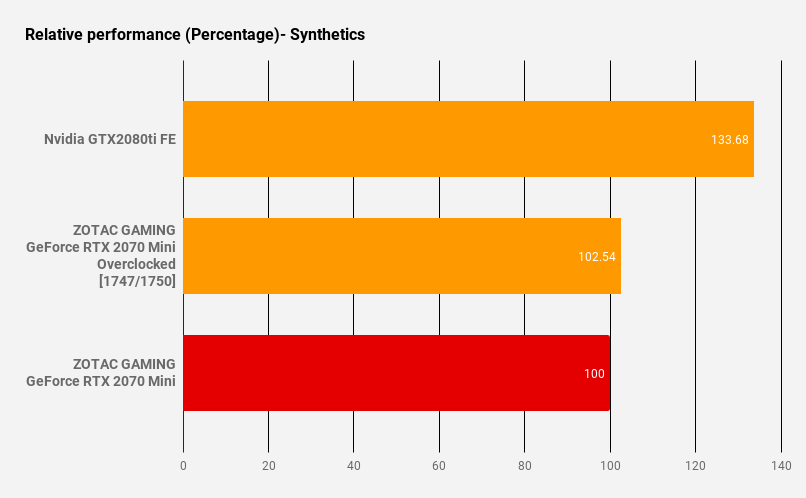
Power Consumption
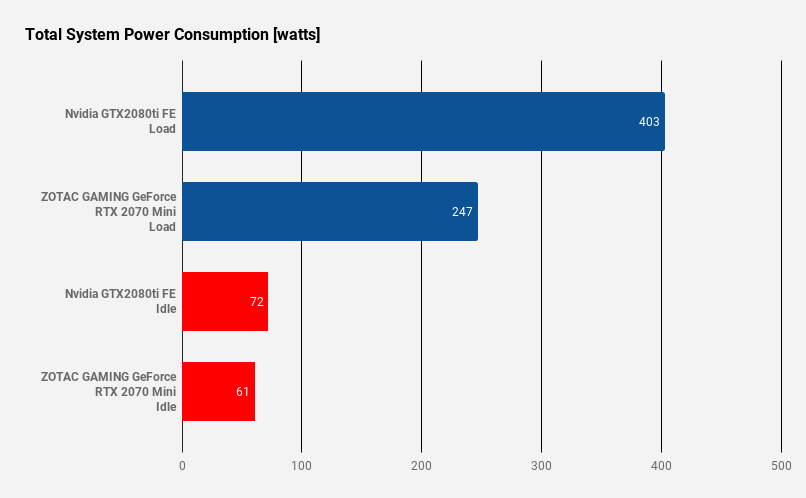
Thermals
The thermals were collected from inside the Louqe Ghost S1 chassis.
Data for 100% GPU usage was collected using Furmark after 15 minutes of stress when the temperatures flat-lined.
As we’ve come to expect from ZOTAC’s custom coolers, the temperatures were decently impressive for an enthusiast-grade graphics card that has been shrunk down to this size.
The highest temperature recorded was 81c (non-overclocked) under 100% synthetic load.
While gaming, the highest temperature recorded was 72c (non-overclocked).
It’s also worth mentioning that the default fan profiles were used for the following results. With a little adjustment the temperature could be even lower, or higher depending on overclock, or if you favor less fan noise.
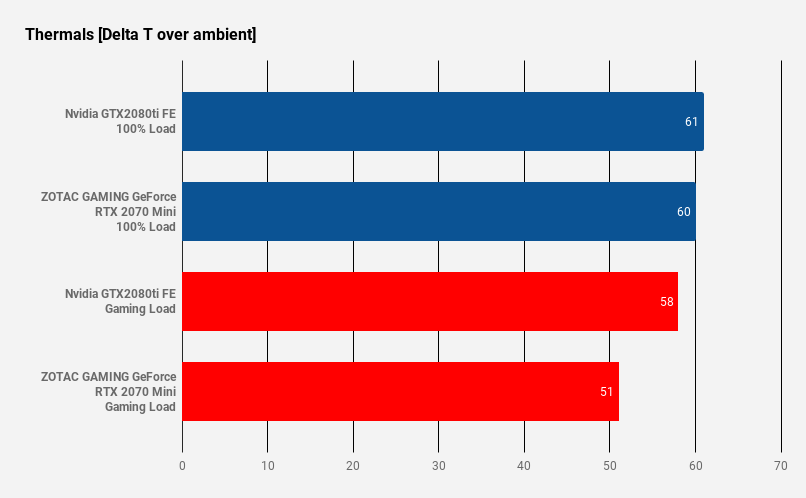
Noise levels
Unfortunately, our review sample had a slight oddity that caused the right-most fan to rub against the plastic shroud when the GPU was under heavy load. The team at ZOTAC tasked their engineers to look into it but due to the GPU being a loaner our review sample had to be sent back. ZOTAC kindly offered to send a replacement sample but unfortunately I had family emergency that left me unable to collect this metric from a replacement GPU.
That said, because of my experience with the ZOTAC 1080 mini that likely uses the same, or incredibly similar fans, I have no doubt that the noise levels would have been completely acceptable at load.
Coil whine was only audible during 3DMark testing -this is normal.
Conclusion
Not much more needs to be said other than the fact that the ZOTAC GAMING GeForce RTX 2070 Mini Cost 55.80% less than the NVIDIA RTX 2080 Ti, but only performed an average of 32.43% slower. That said, the RTX 2070 series performs slightly better than a 1080 mini but not quite as good as a 1080 Ti so it’s not worth the upgrade if you already own a GTX 1080. It you’re coming from an older card, it could offer a substantial bump in performance but like the rest of the RTX lineup, this generation seems premature to the technology stack (Ray tracing and DLSS) that it promises.
With GDDR6 largely responsible for the higher-than-expected prices of this series, those interested in waiting, may see more affordable cards released in 2020 when NVIDIA launches their AMPERE series of cards when GDDR6 is more widely available. However, AMPERE is expected to use PCIe 4.0 so there is possibility that your current PCIe 3.0 setup could become a bottleneck. As result, the wait for a less expensive GPU could require your motherboard and processor to be replaced (depending on how powerful the new GPU is -to avoid a bottleneck) rendering any potential cost savings moot.
In 6 of the 8 games that we tested, the ZOTAC GAMING GeForce RTX 2070 Mini was capable of playing with over 60FPS, at 100% max settings, at a resolution of 3440×1440. With a little adjustment to the settings, this little card would have no problems playing today and tomorrows titles. Just don’t expect it to be a strong contender for next-gen VR -whenever that is.
Pros
- Great Aesthetic
- Terrific price:performance ratio
- Small.
- Recessed 8-pin power
- Non-RGB, just white.
Nitpicks
- Non-RGB (for some of you)
- No support for VisualLink
- No semi-fanless mode.
- Our review sample was louder than normal rendering us unable to collect an accurate dB reading.
- No fault to ZOTAC but NVIDIA has removed SLI support for the 2070 series.
- No fault to ZOTAC but GDDR6 prices are high and it’s unclear when we will see a price drop for the RTX series -especially without competition from AMD.
- No fault to ZOTAC but the RTX lineup of games consists of just Battlefield 5. The Ray tracing implementation has improved but still needs further optimization before these RTX variants can really strut their stuff. Shadow of the Tomb Raider still has not recieved it’s Ray tracing patch.
- No fault to ZOTAC but at time of writing the only title with DLSS support consists of a single buggy benchmark in Final Fantasy XV. Just Cause 4 didn’t ship with it and Battlefield 5 doesn’t support it yet either. Apparently the process for DLSS is far more demanding to implement so this may not see much use outside of a few early showcase titles -whenever that arrives.
Cons
- None
Please let us know what you think about the ZOTAC GAMING GeForce RTX 2070 Mini on the forums.
This review sample was provided by ZOTAC.
Here at SmallFormFactor.net we give manufacturers the ability to be part of the community. We offer a right to reply to our hardware reviews. If a manufacturer responds with any feedback or corrections, their comments will be posted here.
